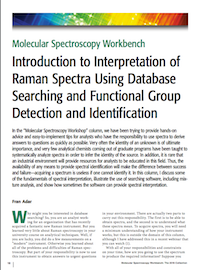Article
Spectroscopy E-Books
Spectroscopy E-Books
Introduction to Interpretation of Raman Spectra Using Database Searching and Functional Group Detection and Identification
Author(s):
In the “Molecular Spectroscopy Workshop” column, we have been trying to provide hands-on advice and easy-to-implement tips for analysts who have the responsibility to use spectra to derive answers to questions as quickly as possible. Very often the identity of an unknown is of ultimate importance, and very few analytical chemists coming out of graduate programs have been taught to systematically analyze spectra in order to infer the identity of the source. In addition, it is rare that an industrial environment will provide resources for analysts to be educated in this field. Thus, the availability of any means to provide spectral identification will make the difference between success and failure-acquiring a spectrum is useless if one cannot identify it. In this column, I discuss some of the fundamentals of spectral interpretation, illustrate the use of searching software, including mixture analysis, and show how sometimes the software can provide spectral interpretation.
Read more
here.
Read
other articles in this E-Book.

Newsletter
Get essential updates on the latest spectroscopy technologies, regulatory standards, and best practices—subscribe today to Spectroscopy.


